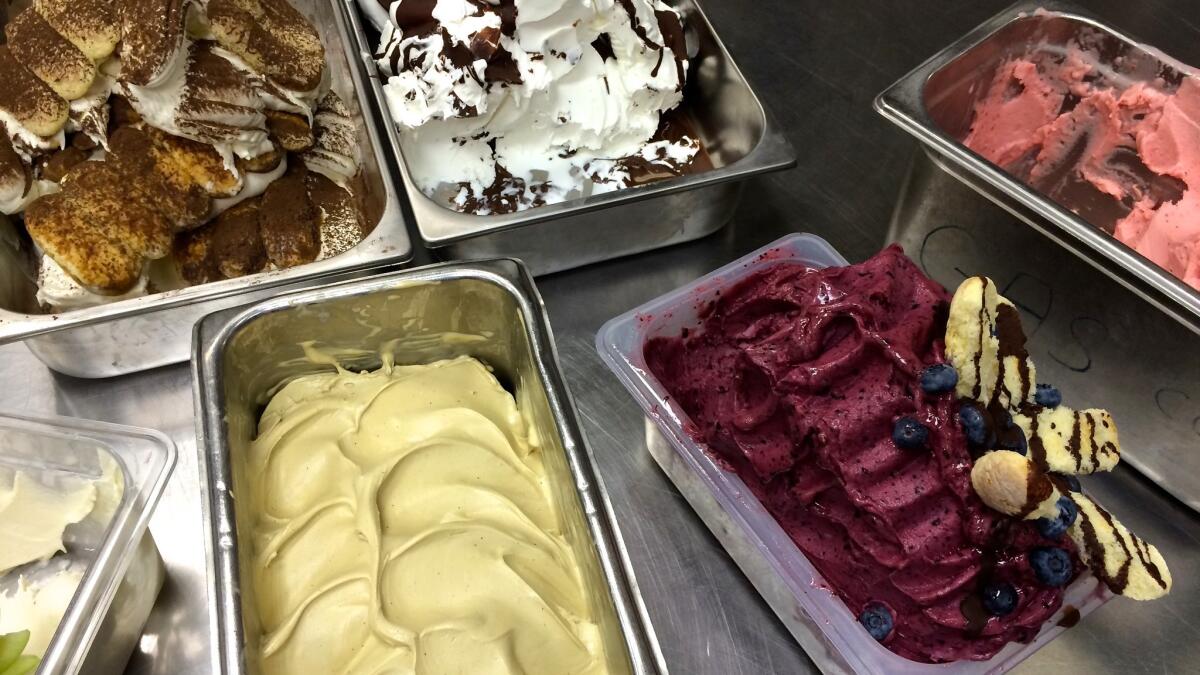Nine things we learned about gelato -- after a day at Gelato University

- Share via
The pistachio comes out of the gelato machine, a fat ribbon of palest khaki green.
“It’s not bright green, because the color comes from just the roasted pistachios, no added coloring,” explains Luciano Ferrari of Carpigiani Gelato University. Carpigiani is a Bologna-based manufacturer of professional gelato machines.
The gelato is dense and very smooth and creamy, the taste just that of roasted pistachios from Sicily. And that creaminess? Hard to believe it doesn’t come from cream, but milk.
At a one-day, pop-up crash course, to which I was invited along with half a dozen other food writers, we learned about gelato’s history, what it is and how it’s made. We also ate more gelato than any of us had ever had in our lives.
Question: Do they give a PhD in gelato?
Before making that batch of sublime pistachio gelato in a $42,000 machine called “Maestro,” Ferrari passes out recipes. My assignment: strawberry sorbetto made with strawberries, sugar, dextrose, lemon juice and water. Basically, it involves weighing out the ingredients and then blending them together using a stick blender that dangles from the ceiling. Then the mix goes into the machine set, in this case, for “gelato excellent.” Ten minutes later the buzzer sounds and it’s done.
The pure strawberry flavor lifted by the lemon juice is impressive. The texture is so creamy, it seems impossible that this sorbetto is made only with water — and has zero butterfat.
Of course, we all have to taste every single one of the flavors we made that afternoon in SoCalGas Company’s test kitchen in Downey. It’s research. And good students all, we reach for yet another paper cup with a scoop of blueberry or mixed berry, banana or mint chocolate chip — and especially for a dreamy tiramisu gelato made with mascarpone and topped with lady fingers soaked in espresso.
What we learned at Gelato U:
1. Gelato is not ice cream. Gelato is made with either milk or water. If it’s made with water, it has a different name, sorbetto.
2. Gelato has far less butterfat content than ice cream. Gelato’s fat content goes from 0 to 8% with a maximum of 10%, while ice cream’s fat content starts at 10% and goes to 18% and often higher, to as much as 30%.
3. The USA is the biggest consumer of ice cream in the world, each of us consuming the equivalent of 5 gallons of ice cream per year. (Another statistic I saw from Datamonitor says we consume 26 liters of ice cream per year, which would put us — whoa — at more than 6 gallons. Each.)
4. Gelato is served several degrees warmer than ice cream, which means the flavor floods your palate immediately. Ever wonder why people fall so hard for gelato? That’s why.
5. Gelato is all about texture. Dense and smooth, that texture is achieved by the proper balance of ingredients.
6. With the new machines, a batch of gelato can be made in as little as 10 minutes. After five minutes in a shock freezer, it’s ready to serve. Small wonder the machine we used is called “Maestro.” Unfortunately, Carpigiani does not make a consumer version.
7. With the advent of new, less sweet sugars, a producer can now tinker with gelato’s sweetness level, something that wasn’t possible before.To achieve the smallest possible ice crystals that give the gelato its characteristic texture, you cannot just add less sugar. But by using regular sugar with a combination of other sugars, including dextrose and several others, it’s possible to make gelato that are less sweet.
8. Italy, a country the size of Arizona, has 39,000 gelato shops. The USA has 900. Nine hundred!
9. As an answer to lactose intolerance, the trend is for non-fruit sorbetto such as chocolate, hazelnut or pistachio.
Follow @sirenevirbila for more on food and wine.
More to Read
Eat your way across L.A.
Get our weekly Tasting Notes newsletter for reviews, news and more.
You may occasionally receive promotional content from the Los Angeles Times.









